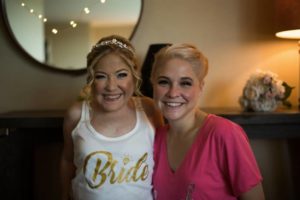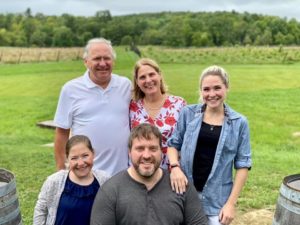What does someone with a rare disease look like? With over 7,000 rare diseases in the world, affecting an estimated 300 million people, life with a rare disease (and people with a rare disease) consists of all different lived experiences. Yet Mallory Cyr, a public health professional and rare disease advocate, shares that:
I think a big problem that we see within this space is that systems have a certain vision of a person with a rare disease.
Both Mallory, now 36, and her younger sister Maisy, now 28, were diagnosed with microvillus inclusion disease (MID) as children. The pair are, to their knowledge, the oldest living people with MID who have not had to undergo an intestinal transplant.

Photo courtesy of Mallory Cyr.
During the pandemic, Mallory and Maisy decided to launch “With Mais and Mal,” a podcast to share their story. In the podcast, no topic is off-limits, from raising children with complex medical needs to having a successful relationship while balancing work, life, and a rare disease. To Mallory, changing the narrative—and showing that life with a rare disease can and should be fulfilling—is so incredibly important. She wants people to push beyond the confines of what they read online solely from medical professionals, and begin listening to those with lived experience, explaining:
Nobody has really wanted to hear our story. They’re going by providers and what they find on the Internet, but we’re here! We want to talk about it!
Recently I sat down with Mallory to discuss what MID is, the process of podcast development, and the desire to advocate for patients.
Microvillus Inclusion Disease (MID)
Microvillus inclusion disease (MID) is a rare inherited intestinal disorder. Myo5b or syntaxin 3 gene mutations cause microvilli on the small intestine to be ingrown, not fully developed, or atrophied. As a result, says Mallory:
The absorption step of digestion is skipped.
Symptoms of MID, which include malabsorption and chronic, watery diarrhea, often appear within a few hours or days following birth. In some cases, however, the symptoms may not appear until months later. Additional characteristics and potential complications include:
- Unintended weight loss
- Dehydration or malnutrition
- Slowed or restricted growth
- Developmental delays
- Metabolic acidosis
- Cholestasis
While the National Organization for Rare Disorders (NORD) explains that only around 100 cases of MID have been reported in medical literature, Mallory believes that it exists at a wider prevalence. She explains:
Babies are often misdiagnosed or just not diagnosed. It took a little while for me to be diagnosed and I have had to, and still have to, explain MID to medical providers. I don’t expect them to know what it is, and I appreciate when providers accept there are things they don’t know but are willing to learn.
Therapies associated with MID include intravenous hydration and nutrients, including total parenteral nutrition (TPN), administered through a central line, which Mallory describes as:
A permanent IV that goes directly to your bloodstream.
It is possible for people to live well into adulthood on TPN. Mallory explains:
We need to change the narrative that life on TPN isn’t possible. There are lots of people who have been on TPN for 20, 30, 40 years. The advocacy is moving faster than the literature, but medical providers need to stop viewing TPN as a death sentence, or something that is only used in end-of-life care. Organizations like the Oley Foundation are made up of hundreds of people who rely on IV nutrition, or tube feeding.
Mallory’s Story
Mallory Cyr was born in the mid-1980s. After she was born, she began displaying a number of symptoms which had doctors initially stumped. She explains:
My parents were really just relying on different medical professionals. I recall my mom saying that we went to a lot of different specialists, and it was a medical student who had read about this and was able to contribute to the diagnosis.
When asked about the diagnostic journey and the earlier stages of treatment, Mallory explains that she doesn’t remember much of the diagnostic process. After all, she was an infant! However, she and Maisy sat down with their mother for a January 17, 2021 episode of “With Mais and Mal” to learn more about the diagnostic journey and talk about what it was really like. Mallory says:
It’s really powerful to hear her share, especially knowing that, at the time, she was basically my baby sister’s age. We talked about how resilient it made her and our entire family. A lot of parents of kids with rare diseases have found hope in this story.

Mallory explains that Maisy was later diagnosed with MID, although their journeys have been a little different:
When I was younger, in early phases of treatment, I didn’t get selenium for the first four or five years. Due to that complication, there were a lot of issues that manifested in growth. My growth plates dissolved and I’m 3’9. With Maisy, my parents had known that it was a genetic condition and there was a risk, so when she was born, they were able to be on the lookout for symptoms. Medical advice had also changed. Maisy, as the second child, is of normal (or typically developing) height.
Additionally, at the time of her diagnosis, medical professionals told Mallory’s parents that she most likely would not live past age two.
Becoming an Advocate
Mallory exceeded the expectations of the literature, and despite challenges, has lived a happy, healthy, and full life. She has a Master’s degree in Public Health and lives in Denver with her husband, Owen, and their dog. She works for a national nonprofit focused on maternal and child health and has worked as a national speaker and advocate for state public health programs. In particular, much of her professional work has focused on systems improvement in terms of medically complex children transitioning to adult healthcare. Much of her advocacy is a result of her own lived experience:
It is already very difficult to find medical professionals as people with rare diseases. Aging with a rare disease is difficult because there’s nobody to bounce things off of. Providers don’t know what is normal for us. I think, within the genetics world, that is part of why I don’t feel like I’ve had a voice until now. I’m not here to discredit anyone’s experience or narrative, but there needs to be a space for adults living with rare diseases to share our experiences too.
For Mallory, part of changing and fixing this issue is ensuring that rare disease stakeholders are not solely focused on either medical assumption about a certain condition, or a cure. She says she actually prefers working with healthcare providers who do not know about MID, as:
It can be too easy to make assumptions about my care or my life. This is a theme—the importance of providers listening to their patients. The biggest requirement I have is that my medical care is a partnership. I have been doing this, living with it, managing it for more than some providers have been practicing. If they don’t respect me as the expert in my own life, or look for ways to work together, it may not be a good fit for either of us. My favorite words that I can hear are, ‘I don’t know, but I’m willing to learn with you and from you.’
For example, Mallory has been very clear that she is content living her life on TPN, and is not at all interested in receiving a transplant, which is what the literature proposes as a long term treatment for MID. But she finds that it can be difficult to express these to doctors or to others in the rare disease community, who feel that there must be some “solution” to what they perceive as problems. In terms of research, she explains, many researchers want to focus on finding a cure, not managing adulthood with rare genetic conditions. Mallory says:
There’s money in a cure and money in experimental treatments. There’s no money in managing a rare disease. With invasive treatments and certain “fixes,” you’re just swapping out one healthcare issue for another. For me, I’m not looking for a solution; I’m looking for someone who can be there when I’m not feeling well and when there’s a crisis. I don’t know what that looks like because there’s no precedent. I’m not looking to be a guinea pig or sacrifice the quality of my life which, frankly, is amazing, just because someone is curious about fixing something, or writing about it.
Quality of Life
Maintaining a good quality of life is something that frequently comes up within the Facebook community that Mallory finds herself in: around 76 families who have experienced MID. She said that this community began when a family, years ago, reached out after finding her blog. Now, the community supports families all over the world. When asked about the best part of being in such a community, Mallory said:
It’s exciting to create this group where people literally thought that their child had a death sentence and now they’re seeing—no, wait, there’s hope. My child can have a future.
Many of those in the group, or at least those with MID, are relatively young. For example, the next oldest after Mallory and Maisy is just starting high school. Within the group, the aim is to help families feel safe sharing their story. Whatever people share, that’s their choice:
We’ve had conversations recently with a family whose daughters are about to hit puberty, and they’re thinking about bone density and birth control and going to school. Other people ask, ‘How can I safely swim? How do you travel? How can we have a normal life?’ It’s really great to tell people what has worked for us and to let them know that the first answer they get, from us or from their doctors, is not the only answer. It’s never ‘no, we can’t,’ but ‘how can we?’
Learn about Mallory and Maisy’s podcasting journey, their favorite topics, and what they hope to cover in the future in Part 2 of the interview here.
You can also listen to “With Mais and Mal” here.






